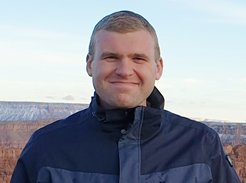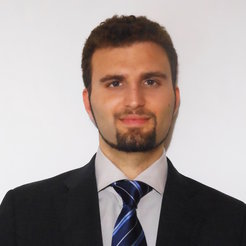Four young E2M scientists receive EUROfusion grants
This year four young scientists from E2M were successful in obtaining EUROfusion grants.
Two EUROfusion Researcher Grants (ERG) were granted to Dr. Michael Griener and Dr. Mikhail Zibrov. Carla Piccinni and Riccardo De Luca received two EUROfusion Engineering Grants (EEG). With the four research and engineering projects all grantees are addressing high priority areas within the EUROfusion roadmap.
Dr. Michael Griener
Origin and dynamics of scrape-off layer filaments

Carla Piccinni and Dr. Michael Griener
In magnetic confinement fusion, transport processes in the plasma edge region determine the power load onto first wall components. In the far plasma edge region close to the wall, the radial outward transport is not dominated by steady state diffusion, but by turbulence driven convective filaments.
To understand the dynamics and origin of these scrape-off layer filaments this research grant combines experimental results with new modelling tools like the GRILLIX code. A key point for the measurements are the unique capabilities of the thermal helium line ratio spectroscopy diagnostic which can deliver filament size and velocities as well as temperature and density of single filaments while simultaneously accessing the plasma edge and scrape-off layer region. The results are compared between different plasma scenarios and different machines in tight collaboration with W7-X and the MST devices ASDEX Upgrade, TCV and MAST Upgrade.
Carla Piccinni
European enhancements for JT-60SA: interfaces and machine integration
JT-60SA is a fully superconducting tokamak device jointly built by Europe and Japan. It will support the ITER program and it will provide key information for the design of DEMO.
For the scientific exploitation of the machine, six enhancements sub-system will be installed on it: massive gas injection, VUV divertor spectroscopy, divertor cryopumps, a pellet launching system (PLS), edge Thomson scattering, and fast ion loss detectors. For the integration of this equipment in the machine, it is of crucial importance to ensure that the requirements and interfaces for the systems are clear and that proper engineering design and quality assurance are applied.
The PLS will be essential on JT-60SA in order to access high-density long-pulse scenarios and also for ELM pacing experiments. Since this project is coordinated by IPP, Carla Piccinni will have a particular involvement into it: She will participate in the realization of the mechanical design and the operation of the existing PLS at ASDEX Upgrade.
Dr. Mikhail Zibrov
Interaction of hydrogen with radiation defects in tungsten

Dr. Mikhail Zibrov
The goal of the project is to gain insight into the processes of hydrogen interaction with major types of radiation defects in tungsten: vacancies, vacancy clusters, and helium bubbles. This will be achieved via dedicated hydrogen isotope-exchange experiments performed under well-controlled conditions. The experimental study will be supported by rate equation simulations yielding fundamental characteristics of hydrogen interactions with the defects.
Riccardo De Luca
Component engineering for first wall limiters

In future reactors, the greatest engineering challenges may arise from the occurrence of plasma disruptions. In extreme cases, first wall sacrificial limiters seem to be unavoidable for the European DEMO, representing the last protection resource to prevent the reactor wall from excessive damage.
The aim of this research project is to design and test mock-ups of a sacrificial limiter, that will be equipped with newly-engineered materials tailored to meet conflicting requirements.
This will be achieved through material characterization and technology R&D. Benefits of advanced manufacturing techniques such as 3D-printing of W-based lattices and novel joining techniques will be exploited. Technologies will be evaluated by extensive high-heat-flux testing of small-scale mock-ups and post-mortem examination.


